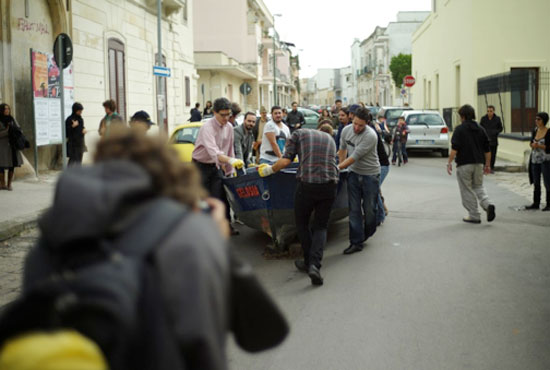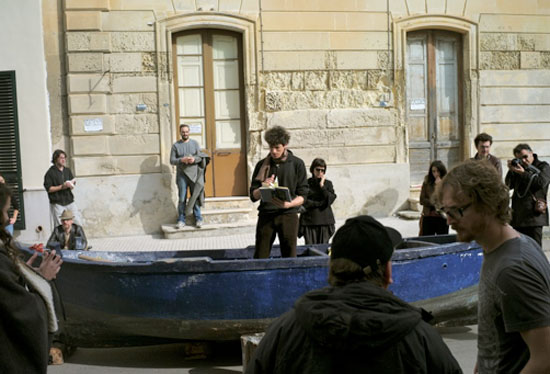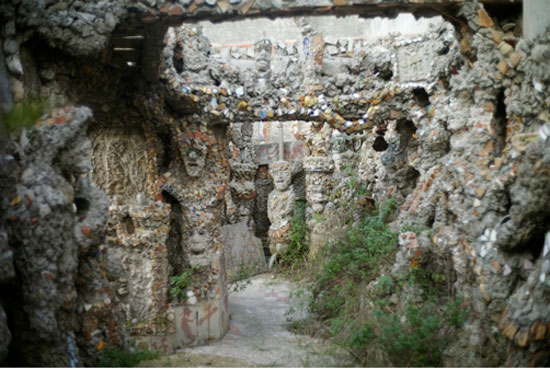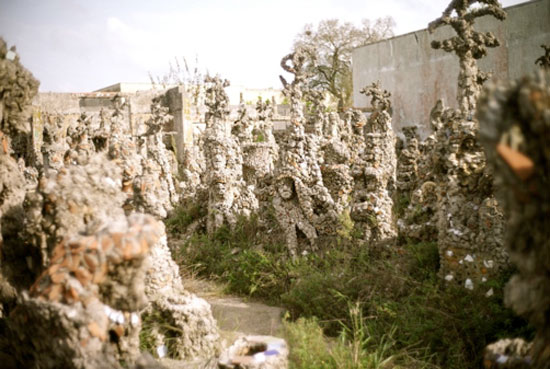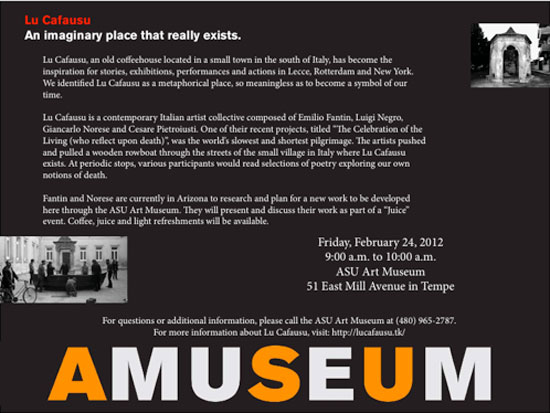Holding the Paradox
7th edition of the Berlin Biennale
curator: Artur Żmijewski
associated curator: Joanna Warsza and Voina, Art Collective
7th Berlin Biennale: Day of Action – Occupy Berlin – video: David Rych
by Emilio Fantin
I found these words of Artur Żmijewski in an interesting press kit:
“The concept of the 7th Berlin Biennal is quite straightforward and can be condensed into a single sentence: we present art that actually works, makes its mark on reality and opens a space where politics can be performed. These works create political events regardless of whether they deal with urgent problems in society or the long-term politics of memory. The “key areas” of our interest are: the political effectiveness of art, the activity of the engaged “intelligentsia” and the creative class (artists in particular), their reactions to the important social issues, as well as the way art is employed to construct historical narratives. We have also worked with artists whose views are radically different from our own and who support political forces that some of us might even consider dangerous. What is at stake here is to present these positions and, if possible to even influence their ideological agendas and goals, rather than keeping a safe and dignified distance.”
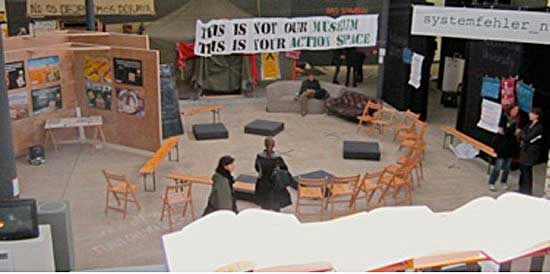
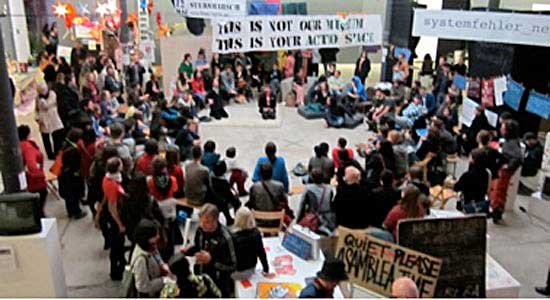
Occupy Biennale photos: ©Massimo Marchetti
The Berlin Biennale, like some other exhibitions I have seen in the last few years, proposes a very strong topic: how art can contribute, support and act politically on social issues. In the KW Institute of Contemporary Art it is not possible to find a single object of art. On the contrary, the various rooms are set up with installations made for practicing politics and actions of antagonism against the State and the institutions. But as we are inside the KW Institute of Contemporary Art, an ambiguity arises between the attitude of political antagonism and the fact that the installations are hosted inside an institution. The curators are pleased to be the artificers of this ambiguous situation where, in good faith, they have tried to transform an art context into a political arena, but the most interesting things cannot be attributed to the idea of their curator, but to the ability of the single visitor (the observer) to discover some unexpected situations that arise casually from this situation; some anomalies unknown to the curators and out of their control. This is a great merit of the curators, whether they are aware or not. And I am not sarcastic in stating that!
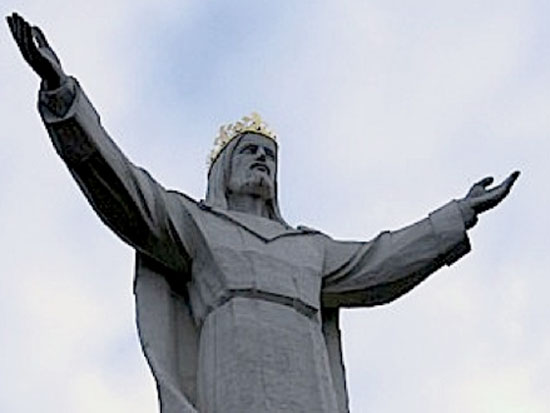
The biggest statue of Jesus Christ. Mirosław Patecki
The dialectic conflict between the idea of art as production of values, which celebrate an individual and egocentric expression, and the idea of art as a production of social and political values and their pragmatic actuation, through a process of sharing ideas and relationships, does not have a solution. The strict capitalistic rule of the celebration of the subject as the individual development of the being on one side, and the political and social investigations about a plural subject on the other side, divides people in two different parties. Those who are convinced that art has to follow a linear and progressive development of the idea of individual profit (defining an art work as an immaterial commodity) and those who think that art has to be an instrument for social and political change (even without the production of any good) must be conceived together. It is not possible to support only one option, because one needs the other. Something is defined as an art work, when it is part of a precise system of reference (the art system): it doesn’t matter if it is a political presidium as “occupy Berlin” or a series of documentaries about demonstrations and actions for human rights or political claims. The art system that reflects the rules and the goals of a capitalistic approach needs a single project, or artist, to reward. It is superfluous if this artist acts for denouncing a lack of human right, or a need of a social transformation. The system feeds on the anti capitalistic and democratic issues too, to consolidate its hierarchic and vertical order based on the celebration of the idea of value as an individual profit. But at the same time, the diffusion of new models and icons (which are the primary matter for creating economic values) allows the communication of democratic ideas that freely circulate among media, galleries, museums and institutions.

Joas Staal’s “New World Summit” represents an alternative parliamentary forum
for terroristic organizations photo: ©Massimo Marchetti
Who is determined to support only one point, forgetting about the other one, doesn’t understand that this dichotomy is producing a new approach to reality. It is not only about art, but also about culture in general. We have to hold the paradox mentally, to accept the contradictions, because only by behaving like that, some undefined and unexpected ideas, communications and visions, will come out. They are information, sensations, perceptions that have not been preventively studied, but they are originated from the contradictions provoked by the terms of the paradox. The funny thing about that is that these anomalies are not objective facts, they do not depend completely on a curatorial approach or on a theoretic affirmation, but they depend also on the relationship between the observed (the object of our consideration) and the observer (ourselves). Inside an art space, (or a cultural space in general) each one of us can have a deep encounter with an object, a situation or an image that becomes significant to him, only because it is happening exactly in that moment, and it creates a short circuit between our inner state and something which belongs to the exterior world. Of course, the artists and the curator have a great responsibility in keeping their proposal opened, (what Umberto Eco calls “Opera Aperta” – open work) to the intellectual or/and physical intervention of the observer.
The responsibility of the “observer” of finding the sense of the encounter with an art work of an artist, an activist or a group of common people, helps the creation of a free space where art invention, inspiration and vision can arise. As it often happens to me when, you go and visit exhibitions, included the Berlin Biennal, you get personal and free gain, discovering and elaborating some unknown and unexpected anomalies, due to the contradiction that arises by facing the two extreme poles of a paradigmatic paradox.

Joanna Rajkowska – “Born in Berlin” (2012),
film still ©Joanna Rajkowska and Andrew Dixon
Escaping the order of a determined preposition that imposes a model, a role, a political behavior and expressing ourselves from a political social and intellectual point of view, means taking into account the limits of the existential paradox, and through it, discovering our inwardness and putting it in relation with the state of things.
ARTUR ŻMIJEWSKI, The Curator of the 7th Berlin Biennale Born in Warsaw in 1966, Artur Żmijewski mainly works with photography and film. In 2005 he represented Poland at the 51st Venice Biennale. In his manifesto The Applied Social Arts he developed his distinct positition on social activism, which also forms the point of departure for the 7th Berlin Biennale.
Joanna Warsza, Associate curator born in 1976, is a curator on the cusp of the performing and visual arts. She graduated from the Warsaw Theater Academy and completed a postgraduate course at the University of Paris 8 dance department. She is a founder of the independent platform Laura Palmer Foundation (www.laura-palmer.pl). Joanna Warsza has worked mostly in the public realm, curating projects that examine social and political agendas, such as the invisibility of the Vietnamese community in Warsaw, the phenomenon of Israeli Youth Delegations to Poland, or the legacy of post-Soviet architecture in the Caucasus.
Voina, Art Collective, Associate curators from Russia, was founded in 2005 by Oleg Vorotnikov and Natalya Sokol. Voina engages in street action art that is directed against the Russian authorities. Their actions are regularly joined by a large group of anonymous activists. Numerous lawsuits have been filed against the group and its activists. Most recently Natalya Sokol and her son Kasper have been arrested for several hours in mid-October 2011. Oleg Vorotnikov, Natalya Sokol, Leonid Nikolajew and Kasper decline the use of money and live in St. Petersburg without a permanent home. Their creed is, as Natalya Sokol declares: “The artist who denies political awareness is just a designer.”
Berlin Biennale (www.berlinbiennale.de) Funded by the German Federal Cultural Foundation, KW held the first Berlin Biennale in 1998 to help the city of Berlin become recognized as a contemporary art capital. Klaus Biesenbach took the artistic helm of the first Berlin Biennale in cooperation with Nancy Spector and Hans Ulrich Obrist. For the second Berlin Biennale in 2001, the baton was passed to Saskia Bos, who is in turn followed by Ute Meta Bauer for the 2004 exhibition. The 4th Berlin Biennale in 2006 was curated by Maurizio Cattelan, Massimiliano Gioni and Ali Subotnick. Adam Szymczyk was chosen for the 5th Berlin Biennale in 2008 who then appointed Elena Filipovic as co-curator. The 6th Berlin Biennale in 2010 was curated by Kathrin Rhomberg. The Biennale is held at various locations in the city, which in the past have included the Neue Nationalgalerie. Artists have included: 3 de luxe, Adolph Menzel, Adrian Lohmüller, Aernout Mik, Ahmet Öğüt, Aida Flüchtlingslager, Aleana Egan, Alexa Hennig von Lange, Alexander Baumgardt / Jan Rikens Hillmann, Alicia Framis, Anatolij Shuravlev, Andrea Zittel, Andreas Kaernbach, Andreas Slominski, Andrée Korpys & Markus Löffler, Andrey Kuzkin, Ania Molska, Anna Baranowski / Luise Schröder, Anna Witt, Ann-Sofi Sidén, Antanas Mockus, Apolonija Sustersic, Aris Fioretos, Armin Linke, Artur Żmijewski, Arturas Raila, Avi Mograbi, Ayse Erkmen, Babette Mangolte, Beatrice Wrobel, Bernard Bazile, Bernd Langer, Bless, Brimboria Institut, Burak Arikan, BUREAU Mario Lombardo, Cameron Jamie, Caner Aslan, Carlos Amorales, Carsten Höller, Cezary Bodzianowski, Charlotte Bank, Christian Jankowski, Christine Hill, Christine und Irene Hohenbüchler, Christoph Keller, Christoph Schlingensief, Claude Lévêque, Cyprien Gaillard, Dan Peterman, Danai Anesiadou, Danh Vo, Daniel Guzmán, Daniel Knorr, Daniel Pflumm, Daniel Roth, Darren Almond, David Claerbout, David Maljković, David Reeb, David Rych, Dominique Gonzalez-Foerster, Douglas Gordon, Eike Becker, Elisabetta Benassi, Ettore Sottsass, F.R.E.d. RUBIN, Fabrice Hybert, Felix Gonzalez-Torres, Femen, Ferhat Özgür, Filmpiraten, Fiona Banner, Fiona Tan, Franz Ackermann, Fred Kelemen, Fred Tomaselli, Friedl vom Gröller (Kubelka), Gabriel Kuri, Gabriel Orozco, Gedi Sibony, George Kuchar, Georges Tony Stoll, Giu Shi-hua, Giulia Piscitelli, Gob Squad, Goshka Macuga, Grüntuch / Ernst, Hajnal Németh, Hans Schabus, Haris Epaminonda, Heike Baranofsky, Henrik Håkansson, Henrik Olesen, Hermann Joachim Pagels, Honey Suckle Company, Inka Essenhigh, Institute for Human Activities, Ion Grigorescu, Jacob Mishori, Jan Liesegang, Janette Laverrière, Jiri Ceiver, Joanna Rajkowska, Joanne Tatham & Tom O’Sullivan, João Penalva, Johannes Kahrs, John Bock, John de Maya, John Smith, Jonas Staal, Jonathan Meese, Jonathan Monk, Jörg Stollmann, Jos De Gruyter & Harald Thys, Joseph Beuys Theater & Teatr.Doc, Joseph Grigely & Amy Vogel, Jürgen Frisch, Karina Dzieweczyńska, Kartenrecht, Katarzyna Józefowicz, Keith Tyson, Kendell Geers, Khaled Jarrar, Kilian Rüthemann, Kohei Yoshiyuki, Krétakör, Kristina Solomoukha, Krytyka Polityczna, Kutlug Ataman, Larry Sultan & Mike Mandel, Lars Laumann, Liam Gillick, Lili Reynaud-Dewar, Little Warsaw, Lou Cantor, LSD, Luciana Lamothe, Ludwig Peter Kowalski, Łukasz Konopa, Łukasz Surowiec, Maciej Mielecki, Manfred Pernice, Manon de Boer, Manuel Ocampo, Marc Camille Chaimowicz, Marcus Geiger, Margaret Salmon, Marie Voignier, Marijke van Warmerdam, Marina Naprushkina, Marion von Osten, Mark Boulos, Markus Muntean / Adi Rosenblum, Marlene Haring, Martin Zet, Masist Gül, Mathieu Mercier, Melvin Moti, Michael Elmgreen / Ingar Dragset, Michael Schmidt, Michael Stevenson, Michał Górczyński, Michel Auder, Minerva Cuevas, Mirosław Patecki, Mobinil, Mohamed Bourouissa, Mona Vătămanu / Florin Tudor, Monica Bonvicini, Mosireen, MVRDV, Nada Prlja, Nairy Baghramian, Nashashibi / Skaer, Navin Rawanchaikul, Nilbar Güreş, Nir Evron, Octavian Trauttmansdorff, Olaf Nicolai, Olafur Eliasson, Oleksiy Radynski, Olga Chernysheva, Our House, Pamela Rosenkranz, Paola Pivi, Parastou Forouhar, Pascale Marthine Tayou, Patricia Esquivias, Patricia Piccinini, Paul Sietsema, Paulina Olowska, Paweł Althamer, Pedro Barateiro, Petrit Halilaj, Phil Collins, Philipp Oswalt, Piotr Uklański, Pipilotti Rist, Pit Schultz, Pixadores, Pleurad Xhafa / Sokol Peçi, Public Movement, Pushwagner, Renée Green, Renzo Martens, Rineke Dijkstra, Rirkrit Tiravanija, Roman Ondák, Ron Tran, Rosângela Rennó, Ruti Sela & Maayan Amir, Sarah Sze, Sean Snyder, Sebastian Stumpf, Shannon Ebner, Simryn Gill & Liisa Roberts, Stan Douglas, Stefan Rusu, Stefan Thater, Steven Pippin, Stiftung Flucht, Vertreibung, Versöhnung, SubREAL, Sung Hwan Kim, Superflex, Surasi Kusolwong, Susan Hiller, Susanne Kriemann, Susanne M. Winterling, Sven-Åke Johansson, Swetlana Heger & Plamen Dejanov, Teresa Margolles, Thatchers, Thea Djordjadze, Thomas Demand, Thomas Hirschhorn, Thomas Judin, Thomas Locher, Thomas Zipp, Till Müller-Klug, Tim Staffel, Tobias Rehberger, Tomáš Rafa, Tris Vonna-Michell, Tsuyoshi Ozawa, Ugo Rondinone, Ulrike Mohr, Vibeke Tandberg, Vincent Vulsma, Vogt + Weizenegger, Walter Musacchi, Wolfgang Tillmans, Xavier Le Roy, Xu Tan, Yael Bartana, Zafeiris Haitidis, Zhao Liang, Zofia Stryjeńska


